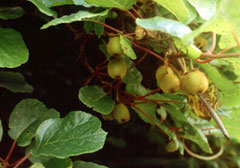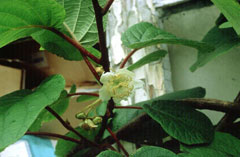 |
|
(c) ken Fern, Plants For A Future 2010 |
 |
| (c) ken Fern, Plants For A Future 2010 |
Translate this page:
Summary
Actinidia includes deciduous shrubs and vigorous, strong-growing vines native to temperate eastern Asia. All members of this genus produce edible fruits. The flowers are sweetly scented. Common Kiwifruit (A. deliciosa) and Hardy Kiwi (A. arguta) are suited to Mediterranean climates; they do less well in arid or semi-arid regions. Common or Fuzzy Kiwifruit is the best-known species growing to 9m (30ft). The fruit, rich in vitamin C, is very juicy and delicious. For a good crop of fruit, prune the plants to keep them small – if left unpruned, they will romp away and grow to the top of trees. Plants are usually either male or female, so you need to grow at least one male plant for every 4 – 5 females to get fruit. Some cultivars do not need a male for fertilisation, though they have inferior fruits. When grown from seed, most of the seedlings are male, so it is best to buy named varieties. Low-chill varieties are available.
Physical Characteristics

 Actinidia deliciosa is a deciduous Climber growing to 9 m (29ft 6in) at a fast rate.
Actinidia deliciosa is a deciduous Climber growing to 9 m (29ft 6in) at a fast rate.
See above for USDA hardiness. It is hardy to UK zone 7 and is not frost tender. It is in flower from July to August, and the seeds ripen from October to December. The species is dioecious (individual flowers are either male or female, but only one sex is to be found on any one plant so both male and female plants must be grown if seed is required). and is pollinated by Bees, insects. The plant is not self-fertile.
It is noted for attracting wildlife.
Suitable for: light (sandy), medium (loamy) and heavy (clay) soils. Suitable pH: mildly acid soils. It can grow in semi-shade (light woodland) or no shade. It prefers dry or moist soil.
UK Hardiness Map
US Hardiness Map
Synonyms
A. chinensis. Hort. non Planch.
Plant Habitats
Woodland Garden Sunny Edge; Dappled Shade; South Wall. By. West Wall. By.
Edible Uses
Edible Parts: Fruit Leaves Seed
Edible Uses:
Fruit - raw or cooked. A delicious flavour[1, 2, 3, 11, 105], the fruit can be up to 8cm long, it is very juicy when fully ripe and has a refreshing, acid flavour[K]. It contains a number of small seeds, but these are easily eaten with the fruit[K]. Rich in vitamin C[183]. Fresh fruits contain 100 - 420mg vitamin C per 100g and 8 - 14% carbohydrate[218]. Acidity is 1 - 2%, mainly citric acid[218]. The fruit ripens in November and can store for 3 - 4 months[132]. Yields of 8 - 30 tonnes per hectare are possible[218]. Leaves are a famine food[179].
References More on Edible Uses
Medicinal Uses
Plants For A Future can not take any responsibility for any adverse effects from the use of plants. Always seek advice from a professional before using a plant medicinally.
Diuretic Febrifuge Sedative Urinary Vitamin C
The fruits, stems and roots are diuretic, febrifuge and sedative[147]. They are used in the treatment of stones in the urinary tract, rheumatoid arthralgia, cancers of the liver and oesophagus[147].
References More on Medicinal Uses
The Bookshop: Edible Plant Books
Our Latest books on Perennial Plants For Food Forests and Permaculture Gardens in paperback or digital formats.

Edible Tropical Plants
Food Forest Plants for Hotter Conditions: 250+ Plants For Tropical Food Forests & Permaculture Gardens.
More

Edible Temperate Plants
Plants for Your Food Forest: 500 Plants for Temperate Food Forests & Permaculture Gardens.
More

More Books
PFAF have eight books available in paperback and digital formats. Browse the shop for more information.
Shop Now
Other Uses
Paper Pencil
Paper is made from the bark[178]. If the bark is removed in one piece from near the root and placed in hot ashes, it becomes very hard and can be used as a tube for a pencil[178]. Nectary - Flowers rich in nectar and pollen: Yes – Kiwifruit plants produce flowers rich in nectar and pollen, attracting pollinators such as bees. 2. Wildlife - Food (Fruit, Seeds, Leaf litter, Shelter, Nesting, Roosting): Yes – The fruit of kiwifruit plants is edible and highly nutritious for humans and wildlife alike. The seeds can also be consumed, and the foliage provides some cover for wildlife, although it is not a primary nesting site. 3. Invertebrate Shelter (Overwintering Sites, Leaf Litter, Ground Cover): The dense foliage can offer shelter for invertebrates, and leaf litter can provide overwintering sites. The sprawling habit of the vine may also create ground cover that is beneficial for various organisms. 4. Pest Confuser (Smell): Yes – The aromatic leaves and flowers of kiwifruit may help confuse pests, potentially providing a degree of pest control.
Special Uses
Food Forest Scented Plants
References More on Other Uses
Cultivation details
Prefers a sound loamy acid soil, it dislikes alkaline soils and becomes chlorotic at pH 6 or higher[11]. Tolerates a pH in the range 5.5 to 7.3. Succeeds in semi-shade but full sun is best for fruit production[3, 126, 200]. Prefers a sheltered position[200]. Does well when grown into trees[K]. Plants requires a 6 - 8 month frost-free growing season[160, 200]. They are hardy to about -12°c when fully dormant but young growth is very subject to damage by late frosts, being killed back at -2°c[160, 200]. Plants also require a winter chilling of 600 - 1100 hours below 7°c and a long warm summer to ripen the fruit[200]. Plants fruit on second year wood or on fruit spurs produced on older wood[126], any pruning is best carried out in the winter[219]. The flowers are sweetly scented[245]. A very ornamental plant[1], it is widely cultivated in warm temperate zones for its edible fruit, there are many named varieties[183, 200]. The fruit can store for up to 9 months at 0°c with a relative humidity of 90%, but under domestic conditions 4 - 6 weeks is optimal[200]. This is a rampant climbing plant, supporting itself by twining around branches etc[200]. Plants have been seen with very good crops of fruit at the Hillier Arboretum in Hampshire in several autumns. These plants had outgrown their planned supports and had climbed 15 metres into neighbouring trees. The main problem with them would be how to harvest the fruit[K]. The female 'Heywood' is the most commonly cultivated form in Britain (1993), its fruits store well but it tends to flower late and there can be problems with pollination[126]. The cultivar 'Blake' is said to be fast cropping and self-fertile[200]. The male 'Tomurii' is free-flowering and disease-resistant[202]. Plants in this genus are notably resistant to honey fungus[200]. Plants are usually dioecious, but hermaphrodite forms are known. However, the fruit quality and yield of these hermaphrodite forms is usually inferior[11]. Male and female plants must usually be grown if seed is required, one male to five or six females is normally adequate. The plant is heat tolerant in zones 9 through 7. (Plant Hardiness Zones show how well plants withstand cold winter temperatures.
Plant Heat Zones show when plants would start suffering from the heat.
The Plant Heat Zone map is based on the number of "heat days" experienced in a given area where the temperature climbs to over 86 degrees F (30°C).
At this temperature, many plants begin to suffer physiological damage. Heat Zones range from 1 (no heat days) to 12 (210 or more heat days).
For example Heat Zone. 11-1 indicates that the plant is heat tolerant in zones 11 through 1.) For polyculture design as well as the above-ground architecture (form - tree, shrub etc. and size shown above) information on the habit and root pattern is also useful and given here if available. Woody. Growth habit is a single or multiple shooting vine from a crown [1-2].
References Carbon Farming Information and Carbon Sequestration Information
Temperature Converter
Type a value in the Celsius field to convert the value to Fahrenheit:
Fahrenheit:
The PFAF Bookshop
Plants For A Future have a number of books available in paperback and digital form. Book titles include Edible Plants, Edible Perennials, Edible Trees,Edible Shrubs, Woodland Gardening, and Temperate Food Forest Plants. Our new book is Food Forest Plants For Hotter Conditions (Tropical and Sub-Tropical).
Shop Now
Plant Propagation
Seed - sow spring in a greenhouse[133]. It is probably best if the seed is given 3 months stratification[113], either sow it in a cold frame as soon as it is ripe in November or as soon as it is received. Fresh seed germinates in 2 - 3 months at 10°c, stored seed can take longer[133]. When they are large enough to handle, prick the seedlings out into individual pots and grow them on in light shade in the greenhouse for at least their first winter. When the plants are 30cm or more tall, plant them out into their permanent positions in late spring or early summer, after the last expected frosts[K]. Most seedlings are male[126]. The seedlings are subject to damping off, they must be kept well ventilated[113]. Cuttings of softwood as soon as ready in spring in a frame[K]. Cuttings of half-ripe wood, July/August in a frame. Very high percentage[113]. Cuttings of ripe wood, October/November in a frame.
Other Names
If available other names are mentioned here
Delicious donkey fruit, Kivi, Meiwei Mihoutao [1-4].
Native Range
TEMPERATE ASIA: Fujian Sheng, Hubei Sheng, Jiangxi Sheng, Sichuan Sheng,[Zhejiang Sheng.
Weed Potential
Right plant wrong place. We are currently updating this section.
Please note that a plant may be invasive in one area but may not in your area so it's worth checking.
Conservation Status
IUCN Red List of Threatened Plants Status :

Growth: S = slow M = medium F = fast. Soil: L = light (sandy) M = medium H = heavy (clay). pH: A = acid N = neutral B = basic (alkaline). Shade: F = full shade S = semi-shade N = no shade. Moisture: D = dry M = Moist We = wet Wa = water.
Now available:
Food Forest Plants for Mediterranean Conditions
350+ Perennial Plants For Mediterranean and Drier Food Forests and Permaculture Gardens.
[Paperback and eBook]
This is the third in Plants For A Future's series of plant guides for food forests tailored to
specific climate zones. Following volumes on temperate and tropical ecosystems, this book focuses
on species suited to Mediterranean conditions—regions with hot, dry summers and cool, wet winters,
often facing the added challenge of climate change.
Read More
Expert comment
Author
(A.Chev.)C.F.Liang.& A.R.Ferguson.
Botanical References
11200
Links / References
For a list of references used on this page please go here
Readers comment